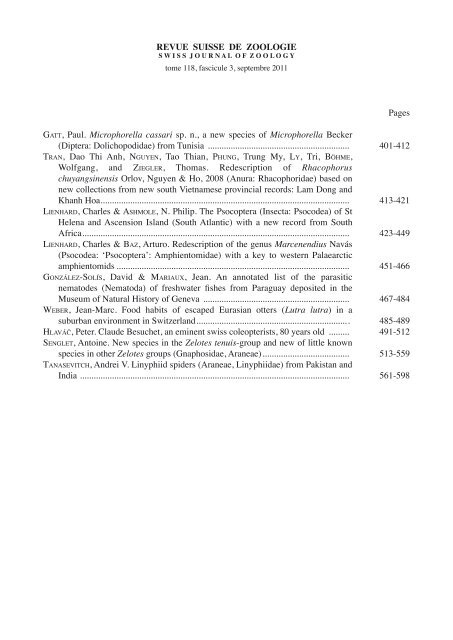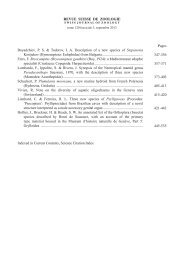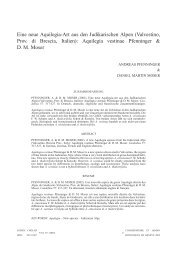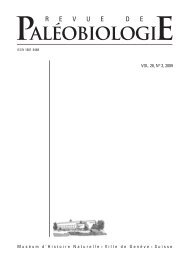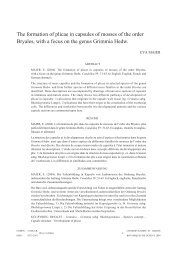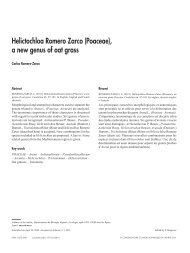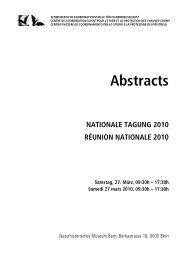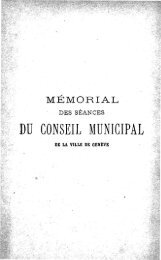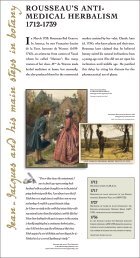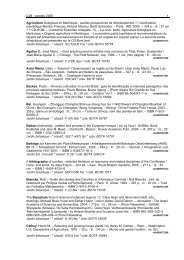Revue suisse de Zoologie GATT, Paul ... - Ville de Genève
Revue suisse de Zoologie GATT, Paul ... - Ville de Genève
Revue suisse de Zoologie GATT, Paul ... - Ville de Genève
You also want an ePaper? Increase the reach of your titles
YUMPU automatically turns print PDFs into web optimized ePapers that Google loves.
<strong>Revue</strong> <strong>suisse</strong> <strong>de</strong> <strong>Zoologie</strong><br />
s W i s s J o u R N A l o F Z o o l o g Y<br />
tome 118, fascicule 3, septembre 2011<br />
Gatt, <strong>Paul</strong>. Microphorella cassari sp. n., a new species of Microphorella Becker<br />
(Diptera: Dolichopodidae) from Tunisia ..............................................................<br />
tran, Dao Thi Anh, nGuyen, Tao Thian, PhunG, Trung My, Ly, Tri, Böhme,<br />
Wolfgang, and ZieGLer, Thomas. Re<strong>de</strong>scription of Rhacophorus<br />
chuyangsinensis Orlov, Nguyen & Ho, 2008 (Anura: Rhacophoridae) based on<br />
new collections from new south Vietnamese provincial records: Lam Dong and<br />
Khanh Hoa .............................................................................................................<br />
Lienhard, Charles & ashmoLe, N. Philip. The Psocoptera (Insecta: Psoco<strong>de</strong>a) of St<br />
Helena and Ascension Island (South Atlantic) with a new record from South<br />
Africa .....................................................................................................................<br />
Lienhard, Charles & BaZ, Arturo. Re<strong>de</strong>scription of the genus Marcenendius Navás<br />
(Psoco<strong>de</strong>a: ‘Psocoptera’: Amphientomidae) with a key to western Palaearctic<br />
amphientomids ......................................................................................................<br />
GonZáLeZ-soLís, David & mariaux, Jean. An annotated list of the parasitic<br />
nemato<strong>de</strong>s (Nematoda) of freshwater fishes from Paraguay <strong>de</strong>posited in the<br />
Museum of Natural History of Geneva ................................................................<br />
WeBer, Jean-Marc. Food habits of escaped Eurasian otters (Lutra lutra) in a<br />
suburban environment in Switzerland ...................................................................<br />
hLaváč, Peter. Clau<strong>de</strong> Besuchet, an eminent swiss coleopterists, 80 years old .........<br />
senGLet, Antoine. New species in the Zelotes tenuis-group and new of little known<br />
species in other Zelotes groups (Gnaphosidae, Araneae) ......................................<br />
tanasevitch, Andrei V. Linyphiid spi<strong>de</strong>rs (Araneae, Linyphiidae) from Pakistan and<br />
India ......................................................................................................................<br />
Pages<br />
401-412<br />
413-421<br />
423-449<br />
451-466<br />
467-484<br />
485-489<br />
491-512<br />
513-559<br />
561-598
<strong>Revue</strong> <strong>suisse</strong> <strong>de</strong> <strong>Zoologie</strong><br />
s W i s s J o u R N A l o F Z o o l o g Y<br />
tome 118, fascicule 3, septembre 2011<br />
Résumés<br />
Microphorella cassari sp. n., a new species of Microphorella Becker (diptera: dolichopodidae) from Tunisia<br />
<strong>Paul</strong> <strong>GATT</strong><br />
Research Associate, Institute of Earth Systems, Chemistry Building 3 rd Floor, University of Malta, Msida MSD 2080,<br />
Malta.<br />
E-mail: paulgatt@onvol.net<br />
Microphorella cassari sp. nov., a new species of Microphorella Becker (diptera: dolichopodidae) from<br />
Tunisia. - A new species of Microphorella Becker, Microphorella cassari sp. n., is <strong>de</strong>scribed from Tunisia.<br />
The strikingly long, strap-like, lanceolate antennal stylus and the long, spine-like setae on the mid-portion of<br />
the costal vein of the male are unique amongst previously <strong>de</strong>scribed species of Microphorella. Likewise, the<br />
completely divi<strong>de</strong>d sternite 10 of the female has not hitherto been recor<strong>de</strong>d in other species of this genus.<br />
Keywords: Diptera - Dolichopodidae - Parathalassiinae - new species - Mediterranean.<br />
Re<strong>de</strong>scription of Rhacophorus chuyangsinensis orlov, Nguyen & Ho, 2008 (Anura: Rhacophoridae) based on new<br />
collections from new south vietnamese provincial records: lam dong and Khanh Hoa<br />
Dao Thi Anh TRAN1,4 , Tao Thien NGUYEN2 , Trung My PHUNG3 , Tri LY1 ,<br />
Wolfgang BÖHME4 , and Thomas ZIEGLER5 1 Vietnam National University, Ho Chi Minh City, University of Science, Faculty of Biology, Department of Ecology<br />
& Evolutionary Biology, 227 Nguyen Van Cu, District 5, Ho Chi Minh City, Vietnam. E-mail: ttadao.hcmuns@gmail.<br />
com<br />
2 Vietnam National Museum of Nature, 18 Hoang Quoc Viet, Hanoi, Vietnam.<br />
3 9A Dong Khoi, Tam Hiep, Bien Hoa, Dong Nai Province, Vietnam.<br />
4 Zoologisches Forschungsmuseum Alexan<strong>de</strong>r Koenig, A<strong>de</strong>nauerallee 160, D–53113 Bonn, Germany. E–mail:<br />
w.boehme.zfmk@uni–bonn.<strong>de</strong><br />
5 AG Zoologischer Garten Köln, Riehler Strasse 173, D–50735 Cologne, Germany. E–mail: ziegler@koelnerzoo.<strong>de</strong><br />
Re<strong>de</strong>scription of Rhacophorus chuyangsinensis orlov, Nguyen & Ho, 2008 (Anura: Rhacophoridae)<br />
based on new collections from new south vietnamese provincial records: lam dong and Khanh Hoa. -<br />
Rhacophorus chuyangsinensis Orlov, Nguyen, & Ho, 2008, which was <strong>de</strong>scribed based on a type series<br />
consisting of three adult males only, is re<strong>de</strong>scribed based on extensive new collections from southern Vietnam.<br />
Our new records consist of 17 individuals, among them the first two females to become known. In our exten<strong>de</strong>d<br />
<strong>de</strong>scription we <strong>de</strong>al for the first time with adult female morphology and with so far unknown colour pattern in<br />
life. Our new records of R. chuyangsinensis for Lam Dong and Khanh Hoa provinces expand the originally<br />
known distribution of this species about 81 km to the Southeast of its type locality (Chu Yang Sin National<br />
Park, Dak Lak Province, southern Vietnam, 1,600 m a.s.l.). We further add additional information on the natural<br />
history of R. chuyangsinensis, which inhabits rocky forest streams at altitu<strong>de</strong>s between 1,320–1,600 m a.s.l.<br />
Keywords: Anura: Rhacophoridae: Rhacophorus chuyangsinensis - morphology, taxonomy, new distribution<br />
data, natural history - Vietnam: Lang Bian Plateau.
The Psocoptera (insecta: Psoco<strong>de</strong>a) of st Helena and Ascension island (south Atlantic) with a new record from<br />
south Africa<br />
Charles LIENHARD 1 & N. Philip ASHMOLE 2<br />
1 Muséum d’histoire naturelle, c. p. 6434, CH-1211 Genève 6, Switzerland.<br />
E-mail: charleslienhard@bluewin.ch<br />
2 Kidston Mill, Peebles, EH45 8PH, U.K.<br />
The Psocoptera (insecta: Psoco<strong>de</strong>a) of st Helena and Ascension island (south Atlantic) with a new record<br />
from south Africa. - Four new species are <strong>de</strong>scribed: Cerobasis atlantica Lienhard sp. n. (Trogiidae) from St<br />
Helena, Sphaeropsocopsis insularum Lienhard sp. n. (Sphaeropsocidae) from St Helena and Ascension Island,<br />
Indiopsocus men<strong>de</strong>li Lienhard sp. n. (Psocidae) from Ascension Island and Blaste helenae Lienhard sp. n.<br />
(Psocidae) from St Helena. The latter is closely related to the St Helena en<strong>de</strong>mic Blaste basilewskyi Badonnel;<br />
this could be an example of sympatric speciation. Helenatropos abrupta Lienhard, formerly supposed to be<br />
a St Helena en<strong>de</strong>mic, is for the first time recor<strong>de</strong>d from South Africa and its male is <strong>de</strong>scribed; it may have<br />
been introduced to St Helena. The recently published doubtful record of the Mexican species Cerobasis maya<br />
García Aldrete from Ascension Island is confirmed. The male of the blind cave-dwelling St Helena en<strong>de</strong>mic<br />
Sphaeropsocopsis myrtleae Lienhard & Ashmole is <strong>de</strong>scribed for the first time; its genital morphology indicates<br />
a close relationship to the African Sphaeropsocopsis reisi Badonnel. Several other species are recor<strong>de</strong>d for the<br />
first time from one or both of these islands. The number of species recor<strong>de</strong>d from St Helena is raised to 23 (6<br />
en<strong>de</strong>mics), that from Ascension Island to 13 (2 en<strong>de</strong>mics). A checklist of the 27 psocid species recor<strong>de</strong>d from<br />
these islands is presented and a brief biogeographical analysis is provi<strong>de</strong>d.<br />
Keywords: Trogiidae - Sphaeropsocidae - Psocidae - new species - new records - cave fauna - blind psocid -<br />
island en<strong>de</strong>mics - island biogeography.<br />
Re<strong>de</strong>scription of the genus Marcenendius Navás (Psoco<strong>de</strong>a: ‘Psocoptera’: Amphientomidae)<br />
with a key to western Palaearctic amphientomids<br />
Charles LIENHARD1 & Arturo BAZ2 1 Muséum d’histoire naturelle, c. p. 6434, CH-1211 Genève 6, Switzerland.<br />
E-mail: charleslienhard@bluewin.ch<br />
2 Universidad <strong>de</strong> Alcalá <strong>de</strong> Henares, Departamento <strong>de</strong> Zoología y Antropología Física, E-28871 Alcalá <strong>de</strong> Henares<br />
(Madrid), Spain.<br />
Re<strong>de</strong>scription of the genus Marcenendius Navás (Psoco<strong>de</strong>a: ‘Psocoptera’: Amphientomidae) with a key<br />
to western Palaearctic amphientomids. - Based on recently collected specimens from continental Spain and<br />
Mallorca island the type species of the genus Marcenendius Navás, 1913, M. nostras Navás, 1913, is re<strong>de</strong>scribed<br />
and tentatively synonymized with the second known species of this genus, M. illustris Navás, 1923. All these<br />
taxa were consi<strong>de</strong>red as enigmatic since their original <strong>de</strong>scription, almost one hundred years ago. Marcenendius<br />
is re<strong>de</strong>fined to contain also the Macaronesian species M. fortunatus (Navás, 1917) comb. nov. and the African<br />
species M. angolensis (Badonnel, 1955) comb. nov., both formerly assigned to Nephax Pearman, 1935. The<br />
diagnosis of the latter genus is revised and for the species N. nepalensis (New, 1973) the original combination<br />
Seopsis nepalensis New comb. rev. is reinstated. An i<strong>de</strong>ntification key to the four amphientomid species known<br />
from the western Palaearctic is presented: Nephax sofadanus Pearman, 1935, N. postalatus Lienhard, 2009,<br />
Marcenendius nostras, M. fortunatus. Nymphs of the latter two species are characterized by the presence of<br />
characteristically curled “corkscrew” hairs on dorsal si<strong>de</strong> of thorax and abdomen, a kind of setae previously<br />
unknown in Psocoptera, which are probably responsible for nymphal camouflage due to adherent dust particles.<br />
Keywords: Nephax Pearman - Spain - Mallorca - Macaronesia - nymphal camouflage - cave fauna - soil fauna.
An annotated list of the parasitic nemato<strong>de</strong>s (Nematoda) of freshwater fishes from Paraguay <strong>de</strong>posited in the<br />
Museum of Natural History of geneva<br />
David GONZÁLEZ-SOLÍS1 & Jean MARIAUX2 1 El Colegio <strong>de</strong> la Frontera Sur (ECOSUR), Unidad Chetumal. Av. Centenario Km. 5.5, C.P. 77900, Chetumal, Quintana<br />
Roo, Mexico. Email: dgonzale@ecosur.mx<br />
2 Dpt <strong>de</strong>s Invertébrés, Muséum d’histoire naturelle, CP 6434, CH-1211 Genève 6, Switzerland.<br />
An annotated list of the parasitic nemato<strong>de</strong>s (Nematoda) of freshwater fishes from Paraguay <strong>de</strong>posited<br />
in the Museum of Natural History of geneva. - The list comprises the evaluation of the material <strong>de</strong>posited<br />
in the Museum d’Histoire naturelle, Geneva, whose taxonomic examination revealed the presence of 78<br />
taxa of parasitic nemato<strong>de</strong>s of freshwater fishes from Paraguay. Out of these, 43 were specifically i<strong>de</strong>ntified,<br />
while 35 larval or subadult forms were only <strong>de</strong>termined at the generic of familial level because of their<br />
<strong>de</strong>velopmental status. A total of 150 new hosts and 44 geographical records were reported in this survey, thus<br />
increasing the number of known nemato<strong>de</strong>s infecting fishes in Paraguay from 28 to 87. Rondonia rondoni and<br />
Procamallanus (Spirocamallanus) inopinatus were the most frequent nemato<strong>de</strong>s both in number of localities<br />
and hosts. Camallanidae was the best represented nemato<strong>de</strong> family with 10 species, followed by Anisakidae (9),<br />
Pharyngodonidae (7) and Cucullanidae (5). The nemato<strong>de</strong> fauna of Paraguyan fishes is quite similar to that of<br />
fishes from Brazil and Argentina.<br />
Keywords: Nematoda - Paraguay - Freshwater - Fishes.<br />
Food habits of escaped eurasian otters (Lutra lutra) in a suburban environment in switzerland<br />
Jean-Marc WEBER, KORA, Thunstrasse 31, 3074 Muri, Switzerland.*<br />
E-mail: jmweber@bluewin.ch<br />
Food habits of escaped eurasian otters (Lutra lutra) in a suburban environment in switzerland. - In 2005,<br />
a male and a female otters escaped from the zoo of Bern, and settled in the nearby River Aar. The number of<br />
otters present in the area increased to 5 individuals after the adult pair reproduced. A monitoring was launched<br />
in 2007 in or<strong>de</strong>r to examine how these otters live in this suburban environment. Food habits notably were<br />
investigated. Fish constituted the staple prey (91.5 %) with salmonids being the most frequently eaten prey<br />
category (43.1 %). Seasonal dietary variation occurred but was not marked. The results and the perspective of<br />
a long-term survival of otters are discussed with regards to the overall <strong>de</strong>crease in fish numbers recor<strong>de</strong>d in the<br />
Swiss waters.<br />
Keywords: Eurasian otter - Lutra lutra - diet - Switzerland.<br />
Clau<strong>de</strong> Besuchet, an eminent swiss coleopterists, 80 years old<br />
Peter HLAVÁČ<br />
Na doline 14, SK-040 14 Košice, Slovakia. E-mail: phlavac@stonline.sk<br />
INTRODUCTION<br />
As a schoolboy I was, as many others, interested in beetles, I collected large and atractive beetles such as<br />
Cerambycidae, Buprestidae, Carabidae etc... but this was only for a relatively short period and when I entered grammar<br />
school I started to be interested in many other things. It was almost 20 years later, when, as a stu<strong>de</strong>nt of the University<br />
of Pierre and Marie Currie in Paris, I visited the Museum of Natural History in Paris and especially the book shop<br />
of this institution. I was browsing shelves full of very nice books on the nature, birds, mammals when I came to the<br />
insect section and I found the book which immediately fascinated me and attracted my full attention: Faune <strong>de</strong> France,<br />
Pselaphidae by René Jeannel. I was enchanted by a beauty of this small beetles. I immediately, although it was at that<br />
time horribly expensive for me, bought it and <strong>de</strong>ci<strong>de</strong>d that this will be my hobby and I will start to study the taxonomy<br />
of Pselaphidae. Later I ad<strong>de</strong>d to my sphere of interest Scydmaenidae and myrmecophilous beetles of other families<br />
but that is an another story. Since my early beginning it was just only short period of time until I ma<strong>de</strong> contact with all<br />
actively working Pselaphidologists and started to search for reprints of their papers. Thus in 1994 I wrote to Clau<strong>de</strong><br />
Besuchet hoping he would send some reprints to me, a totally unknown beginner from small east European country.<br />
After two weeks I received a large package from Geneva. I openned it and it contained almost all Clau<strong>de</strong> Besuchet’s
papers together with nice encouraging letter. “Soyez les bienvenus parmi les entomologistes étudiants les Psélaphi<strong>de</strong>s<br />
et Scydmaeni<strong>de</strong>s” (“Welcome between entomologists studying Pselaphinae and Scydmaenidae”) these were the first<br />
words of the letter and since then Mr. Besuchet and I have met many times, and for me it is always an event to discuss<br />
on Pselaphines with him and to draw from his never ending knowledge of this tiny but very beautifull beetles. So, Mr.<br />
Besuchet, thanks for the invitation and the opportunity for me to remind to all entomologists a little about your 80 years<br />
of life of which 63 were very much <strong>de</strong>voted mainly to your studies of Pselaphines.<br />
New species in the Zelotes tenuis-group and new or little known species in other Zelotes groups (gnaphosidae,<br />
Araneae)<br />
Antoine SENGLET<br />
Route <strong>de</strong> Begnins, 19, CH-1267 Vich, Switzerland. E-mail: a.senglet@bluewin.ch<br />
New species in the Zelotes tenuis-group and new or little known species in other Zelotes groups<br />
(gnaphosidae, Araneae). - Notes are given on mating mechanisms of Z. tenuis and Z. semirufus in the<br />
Z. tenuis-group. Eight species are recognized in the Z. tenuis-group. The following synonyms and new<br />
combinations are proposed: Trachyzelotes manytchensis Ponomarev & Tsvetkov = Zelotes manytchensis, Z.<br />
ruscinensis Simon = Z. semirufus (L. Koch), Z. fuscotestaceus (Simon) = Z. tenuis (L. Koch), Z. <strong>de</strong>nisi Marinaro<br />
= Z. criniger Denis and Z. sumchi Levy = Z. metellus Roewer. Z. babunaensis (Drenski) is revalidated. First<br />
<strong>de</strong>scription are given of the male of Z. babunaensis, the male of Z. metellus, the female of Z. flagellans (L.<br />
Koch), and of the following eight species: Z. alpujarraensis sp. n., Z. baeticus sp. n., Z. chaniaensis sp. n., Z.<br />
cordubensis sp. n., Z. egregioi<strong>de</strong>s sp. n., Z. hispaliensis sp. n., Z. laconicus sp. n. and Z. pediculatoi<strong>de</strong>s sp. n.<br />
Keywords: Arachnida - taxonomy - mating mechanism.<br />
linyphiid spi<strong>de</strong>rs (Araneae, linyphiidae) from Pakistan and india<br />
Andrei V. TANASEVITCH<br />
Centre for Forest Ecology and Production, Russian Aca<strong>de</strong>my of Sciences, Profsoyuznaya Str. 84/32, Moscow 117997,<br />
Russia. E-mail: and-tan@mail.ru<br />
linyphiid spi<strong>de</strong>rs (Araneae, linyphiidae) from Pakistan and india. - 37 linyphiid species are recor<strong>de</strong>d<br />
from Pakistan and India, 15 of which are <strong>de</strong>scribed as new: Acartauchenius himalayensis sp. n., Agyneta<br />
pakistanica sp. n., Anguliphantes nepalensoi<strong>de</strong>s sp. n., Gongylidioi<strong>de</strong>s keralaensis sp. n., G. pectinatus sp. n.,<br />
Halorates concavus sp. n., Indophantes tonglu sp. n., Pelecopsis indus sp. n., Tapinocyboi<strong>de</strong>s bengalensis sp.<br />
n., Tchatkalophantes baltistan sp. n., Tiso incisus sp. n., T. (?) indianus sp. n., Walckenaeria saetigera sp. n. A<br />
new genus, Paracymboi<strong>de</strong>s gen. n., is erected for Paracymboi<strong>de</strong>s tibialis sp. n. (the type species) and P. aduncus<br />
sp. n. One new synonym is established: Walckenaeria nepalensis Wun<strong>de</strong>rlich, 1972 syn. n. = W. martensi<br />
Wun<strong>de</strong>rlich, 1972. A distribution pattern is indicated for many species. Seven species, i.e., Agyneta nigripes<br />
(Simon, 1884), Archaraeoncus prospiciens (Thorell, 1875), Ceratinella wi<strong>de</strong>ri (Thorell, 1871), Maso sun<strong>de</strong>valli<br />
(Westring, 1851), Microbathyphantes palmarius (Marples, 1955), Porrhomma pygmaeum (Blackwall, 1834), and<br />
Tenuiphantes tenuis (Blackwall, 1852) are recor<strong>de</strong>d from the Himalayas for the first time.<br />
Keywords: Arachnida - new genus - new species - new record - Himalayas.


